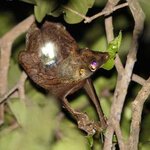Ecology & Zoology

While studying towards his doctorate of philosophy, Anders Jørgensen discovered a previously undescribed species of parasite that infects farmed fish and produces serious disease.
Single-celled parasites of the genus Spironucleus are known to produce serious illness in farmed and aquarium fish. In farmed salmon, these parasites create foul-smelling, puss-filled abscesses in muscles and internal organs. After the first outbreaks of this disease were described in farmed salmon in the late 1980’s, it was assumed that the cause was Spironucleus barkhanus, which is a fairly common parasite in the…

In response to Wright and Muller-Landau’s paper on the future of tropical forests (which suggests that declining rural populations can allow forest recovery; see my previous post), Sloan pointed out reduced rural population often leads to increased deforestation. Really that’s not a huge surprise - peasant farmers tend to have limited labour to clean and plant land, and being capital-limited they tend not to be able to switch to mechanised agriculture.
Thus, they are likely to leave a substantial portion of the landscape either forested - either ’still’ forested (because they haven’t cleared…

Nothing would seem to be stranger than bats flying without their special radar. They would be the Keystone Cops of zoology. But the discovery of a remarkably well-preserved fossil representing the most primitive bat species known to date demonstrates that the animals evolved the ability to fly before they could echolocate.
The new species, named Onychonycteris finneyi, was unearthed in 2003 in southwestern Wyoming and is described in a study in the Feb. 14 issue of the journal Nature, on which University of Michigan paleontologist Gregg Gunnell is a coauthor along with researchers from the…

The traditional idea of the balance of nature gets quite a beating by a study that appears in the current issue of Nature. Using a long-term laboratory experiment, the authors conclude that, even under constant conditions, all species in a food web continued to fluctuate in a chaotic fashion. Chaos makes long-term prediction of species abundances impossible.
Theoretical ecologists already argued in the 1970s that populations of plants and animals might fluctuate in an unpredictable manner, even without external influences. These predictions, derived from chaos theory, attracted a lot of…

According to the Chinese proverb, a bird sings because it has a song, not because it has an answer. A team of French and Brazilian researchers, however, may have the answer as to how the song of Brazilian white-browed warbler has become so well-adapted to the acoustic properties of the rainforest environment.
Understanding the evolution of acoustic communication systems in animals is a hot topic in evolutionary biology and one of the main challenges is to understand how environmental pressures drive this evolution. Mathevon and his colleagues show that the song of the white-browed warbler, a…

In a fairly optimistic paper published in Biotropica in 2006 Joseph Wright and Helene Muller-Landau suggested that declining rates of population growth in tropical countries, coupled with increased urbanisation "give reason to hope that deforestation will slow, natural forest regeneration through secondary succession will accelerate, and the widely anticipated mass extinction of tropical forest species will be avoided." Their assertions have been controversial, and have attracted a fair bit of criticism.
In a July 2007 paper Sean Sloan questioned the assumption that declining rural…

The colugo doesn't fly and is not a lemur but it's still called a "flying lemur" - and it's the champion of all gliding mammals, able to drop from the forest canopy in Malaysia, glide more than the length of two football fields, execute 90-degree turns and then alight gently on a tree trunk.
The colugo looks like a very large squirrel with membranous skin stretching from each limb and even between its toes to catch the wind and work as a parachute. When fully spread, the skin flaps reach the size of a large doormat.
Researchers are discovering how these animals move with the help of a…

Anyone who has conducted field research knows that the very process of collecting data alters the system that you are studying. As you walk across a field, forest or stream to collect data, your footfalls trample vegetation, they compact the soil, they scrape algae off the rocks.
Survey work usually involves a single visit to a site - as long as you avoid sampling from the areas you have trampled, it’s usually pretty safe to assume that your presence is unlikely to have affected the data that you have collected. Permanent plots are a different matter - because these plots are repeatedly…

Anoop Sindhu and colleagues report on a gene that may have played a key role in the evolution of grasses. The gene, Hm1, provides resistance against Cochliobolus carbonum race 1 (CCR1), a fungus that is capable of attacking and killing corn at any stage of its development (images of CCR1 infection). While CCR1 is only known to affect corn, the gene Hm1 and its relatives are present throughout the grass family, but are absent from other lineages.
CCR1 is only known as a disease in Zea mays, but the Hm1 family of genes throughout the grass family. Sindhu and colleagues silenced the…

A study by UC Irvine ecologists finds that excess nitrogen in tropical forests boosts plant growth by an average of 20 percent, countering the belief that such forests would not respond to nitrogen pollution.
Faster plant growth means the tropics will take in more carbon dioxide than previously thought, though long-term climate effects are unclear. Over the next century, nitrogen pollution is expected to steadily rise, with the most dramatic increases in rapidly developing tropical regions such as India, South America, Africa and Southeast Asia.
Nitrogen fertilizer, applied to farmland to…